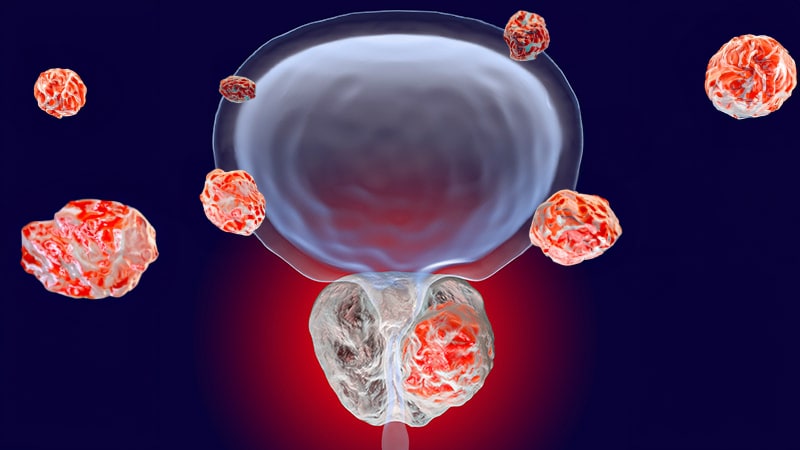TOPLINE:
Among US men with grade group 1 (GG1) prostate cancer, about 1 in 6 had intermediate- or high-risk disease, along with increased rates of adverse pathology and cancer-specific mortality. This finding suggests that GG1 prostate cancer should not be reclassified as noncancerous, as some experts have proposed.
METHODOLOGY:
- Some experts have pushed to reclassify GG1 prostate cancer as a noncancerous entity to help reduce overtreatment. GG1 status is primarily designated via biopsy, but current guidelines recommend treatment decisions be based on a range of parameters, including prostate-specific antigen (PSA) levels, clinical stage, and tumor volume.
- Arguing against reclassification, researchers analyzed how localized GG1 prostate cancer varies by National Comprehensive Cancer Network (NCCN) risk groups, treatment, and cancer-specific outcomes.
- The researchers used the Surveillance, Epidemiology, and End Results database to identify 117,162 men diagnosed with localized GG1 prostate cancer (median age, 64 years) between January 2010 and December 2020.
- Patients were stratified by NCCN risk groups: low-risk, favorable intermediate-risk (n = 10,440; 9%), unfavorable intermediate-risk (n = 3145; 3%), and high-risk (n = 4539; 4%) — meaning 16% had non-low-risk disease.
- Outcomes included adverse pathology (> pT3, GG3-5 or pN+) at radical prostatectomy, prostate cancer-specific mortality, and trends in the management of GG1 prostate cancer. Comparisons with SEER patients with GG2 disease were included for context. The median follow-up was 58 months.
TAKEAWAY:
- Rates of adverse pathology at prostatectomy increased from 16% in low-risk GG1 disease to 60% in high-risk GG1 disease. In adjusted analyses, compared with low-risk prostate cancer, favorable intermediate-risk GG1 prostate cancer was associated with 1.42-fold higher odds of adverse pathology, unfavorable intermediate-risk GG1 with 2.31-fold higher odds, and high-risk GG1 with 7.15-fold higher odds.
- At 10 years, the cumulative incidence of prostate cancer-specific mortality was 1.3% for low-risk GG1, 2.0% for favorable intermediate-risk GG1, 2.4% for unfavorable intermediate-risk GG1, and 4.7% for high-risk GG1. Compared with low-risk GG1 disease, the risk for death from prostate cancer was higher for favorable intermediate-risk (adjusted hazard ratio [aHR], 1.60), unfavorable intermediate-risk (aHR, 2.10), and high-risk (aHR, 3.58) GG1 prostate cancer.
- Mortality rates among patients with intermediate-risk GG1 cancer were comparable to that of patients with favorable intermediate-risk GG2 disease, at 2.1%. However, mortality among high-risk GG1 patients (4.7%) was significantly higher (P < .001).
- Regarding trends in the management of GG1 prostate cancer, active surveillance rose from 4% to 19% for unfavorable intermediate-risk disease, and from 9% to 25% for high-risk disease (P < .001). The data suggest high-risk patients are being undertreated, the authors wrote, “possibly due to conflation of grade and risk.”
IN PRACTICE:
Prostate cancer-specific mortality for men with GG1 disease “increases substantially across National Comprehensive Cancer Network risk groups,” the authors concluded. “Designating GG1 on biopsy as noncancer without considering the prognostic values of adverse clinical features may lead to undertreatment and an increased risk of cancer-specific death in men with non-low-risk disease.”
SOURCE:
The study, led by Neal A. Patel, MD, Weill Cornell Medicine, New York City, was published online in JAMA Oncology.
LIMITATIONS:
Analysis lacked data on MRI and targeted biopsy use and did not account for prostate volume, which affects PSA levels. Histologic grading varied across pathologists due to nonstandardized assessments. Additionally, details on active surveillance intensity and watchful-waiting protocols were unavailable.
DISCLOSURES:
The study received support from the Frederick J. and Theresa Dow Wallace Fund of the New York Community Trust and the Sandra and Edward Meyer Cancer Center of Weill Cornell Medicine. One author reported serving on the advisory board for Lantheus, Lynx Dx, Pacific Edge, and Pfizer/Astellas and receiving grants from the National Cancer Institute outside the submitted work. No other conflicts of interest were reported.
This article was created using several editorial tools, including AI, as part of the process. Human editors reviewed this content before publication.
Source link : https://www.medscape.com/viewarticle/dont-reclassify-grade-group-1-prostate-cancer-new-data-2025a1000l8n?src=rss
Author :
Publish date : 2025-08-11 12:31:00
Copyright for syndicated content belongs to the linked Source.
